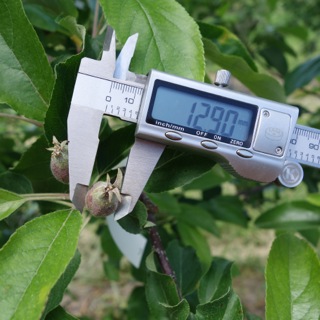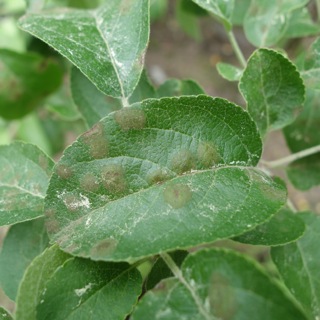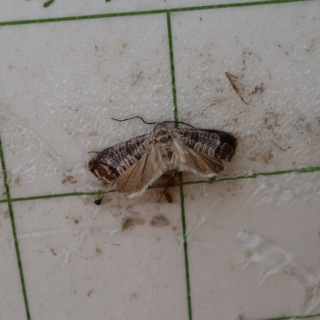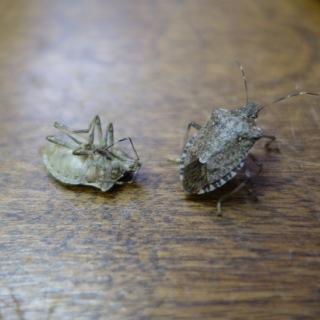

Jon Clements, Editor
Current degree day accumulations
| UMass Cold Spring Orchard, Belchertown, MA |
9-June, 2014 |
| Base 43 (SkyBit) | 855 |
| Base 50 (NEWA) | 539 |
| Coming events | Degree days (Base 43) |
| Codling moth 1st flight peak | 561-991 |
| Lesser apple worm 1st flight peak | 349-761 |
| European red mite summer eggs hatch | 737-923 |
| San Jose scale 1st flight subsides | 855-1227 |
| Obliquebanded leafroller 1st trap catch | 812-986 |
| Obliquebanded leafroller 1st flight peak | 830-1204 |
| Spotted tentiform leafminer 2nd flight begins | 992-1166 |
| Redbanded leafroller 1st flight subsides | 592-898 |
| Spotted tentiform leafminer 1st flight subsides | 668-950 |
| Cherry fruit fly 1st catch | 755-1289 |
| Dogwood borer 1st catch | 819-1299 |
| Peachtree borer 1st catch | 797-1341 |
Key insect life cycle and management dates
Note: for 2014, we have four Massachusetts orchard locations subscribed to AR: Belchertown, Groton, Phillipston, and Sutton. The website for looking at AgRadar for these locations is: http://extension.umaine.edu/ipm/programs/apple/pestcasts/
Dogwood borer (DWB) -- first borer egg hatch roughly: June 28. Peak hatch roughly; August 2
Codling moth (CM) -- 1st generation, first sustained trap catch biofix date: May 20, Tuesday. Codling moth development as of June 9: 1st adult emergence at 45% and 1st generation egg hatch at 1%. In most orchards, insecticide targetted against plum curculio and apple maggot prevent codling moth damage. If targetted codling moth control is needed, key management dates are shown here: 1st generation 3% CM egg hatch: June 10, Tuesday = target date for first spray where multiple sprays needed to control 1st generation CM. 1st gerneration 20% CM egg hatch: June 16, Monday = target date where one spray needed to control 1st generation CM.
Lesser Apple Worm (LAW) -- 1st LAW flight begins around: May 16, Friday; Peak trap catch: May 26. 2nd LAW fligth begins around: July 14, Monday.
Obliquebanded leafroller (OBLR) -- 1st generation OBLR flight begins around: June 12, Thursday. Early egg hatch and optimum date for initial application of B.t, Delegate, Proclaim, Intrepid, Rimon, Altacor, Belt, Voliam Flexi, pyrethroid or other insecticde effective against OBLR (with follow-up applications as needed); June 27, Friday.
Oriental fruit moth (OFM) -- 1st generation OFM flight starts: May 9, Friday; 1st generation 55% egg hatch and first treatment date, if needed: June 2, Monday. 2nd generation OFM flight begins around: July 1, Tuesday.
Plum curculio (PC) -- Increase risk of PC damage as McIntosh and similar cultivars increase fruit size: May 26, Monday; Earliest safe date for last PC insecticide spray: June 11, Wednesday. If relying by repellence by Surround instead of PC mortality by insecticide, Surround coverage should be maintained until PC egglaying begins to decline naturally around Tuesday, July 1.
San Jose scale (SJS) -- First adult SJS caught on trap: May 25, Sunday; 1st generation SJS crawlers appear: June 21, Saturday.
Spotted tentiform leafminer (STLM) -- 1st STLM flight, peak trap catch: May 16, Friday. 1st generation sapfeeding mines start showing: May 24, Saturday. Optimum sample date is around Monday, May 26, when a larger portion of the mines are visible. 2nd STLM flight begins around June 19: Thursday. 2nd STLM flight begins around June 19, Thursday. Rough guess of when 2nd generation sap-feeding mines begins showing: July 8, Tuesday.
9-July, 2014. Annual Summer Meeting of the Massachusetts Fruit Growers' Association. 10 AM to 3 PM, UMass Cold Spring Orchard, Belchertown, MA. Details TBA.
Jon Clements
It almost seems like it is quieting down a bit. Primary apple scab season is over. Plum curculio sprays have been applied, maybe you will need one more? Chemical thinners have been applied to apples, now we are waiting for the results to determine how much hand-thinning remains. Fertilizer has been applied, although there may be room for another nitrogen application before July 1. It's been wet enough, but barely -- young orchards for sure need water. What's on the horizon? Begin hand-thinning of peaches (what remains) as soon as practicable. Obliquebanded leafroller (OBLR) pheromone traps should be up, and orchards with a perpetual problem with OBLR will be spraying for it at the end of this month. Burr-knots in dwarf apple blocks are susceptible to dogwood borer infestation, and now is a good time to apply a trunk spray of Lorsban as adults are flying and beginning to lay eggs.
I have been out and about a bit lately, so I will share what I have seen with some picts:
 |
The normal apple chemical thinning window has passed as fruitlets are approaching 15-20 mm in diameter (or bigger!). Where chemical thinners have been applied, it looks pretty good with fruit thinning down quite nicely. If your fruits are in the 20 mm range and you still feel the need to chemical thin, your best bet is to use Ethrel -- see the fact sheet Late Season "Rescue" Thinning with Ethephon |
| Fire blight has started to rear it's ugly head, in some cases, quite severe. Almost universally, orchards where blossoms were protected by streptomycin spray(s) during bloom are free of fire blight. At this point, obvious fire blight strikes should be cut-out (well below the affected wood into clean wood) on a dry day, and sterilize pruners between cuts (ideally). For more information on managing fireblight see the fact sheet An Annual Fire Blight Management Program for Apples |  |
 |
Apple scab lesions are clear in unsprayed McIntosh. These were likely from major primary infection period May 15-16. Needless to say, if you find scab in your orchard now, you need to keep applying fungicide(s). |
| Codling moth (CM) pheromone trap catches have been consistent at the UMass Orchard, beginning in late May with a biofix, and a bit of a peak sometime last week. Insecticide sprays for curculio generally help take care of CM, but some orchards need to specifically treat for CM -- the timing appears to be sometime next week for this insecticide application. Consult the 2014 New England Tree Fruit Management Guide for specific insecticide recommendations (there are many). |  |
 |
Last but not least, there has been a definite up-tick in reports of Brown Marmorated Stink Bug (BMSB) in Massachusetts beginning last year. These here were collected just this past weekend in a farm structure. Not sure when this is going to become an agricultural pest of importance here, but this might be the year. If you have any suspect BMSB please let me know. Take a good picture and send it to me or I will come out and look. For more information, see Brown Marmorated Stink Bug Introduction on the UMass Fruit Advisor. Also, a fact sheet from MDAR is very good -- Pest Alert: Brown Marmorated Stink Bug |
Jon Clements
See Upcoming Pest Events and AgRadar above for current pest status.
Chemical Thinning
Duane Greene
Fruit continue to increase in size. In blocks that I visited yesterday fruit size ranged from 16 to 19 mm. This means that the effective chemical thinning season for 2014 has just about come to an end. Thinning sprays that went on last week appear to be working. The weather for the week is forecast to be unsettled with the possibility of rain nearly every day. Given that thinners effects are starting to manifest themselves it is prudent to wait now until you can get a clearer picture before making any other thinning decisions. The primary option growers have when fruit size is 20 mm or more is ethephon plus carbaryl. This is a last resort option. Assess set this weekend and then make the decision at the end of the weekend if further chemical thing is necessary or appropriate.
Follow me (jmcextman) on FB: https://www.facebook.com/jmcextman


UMass Fruit Advisor: http://umassfruit.com
Scaffolds Fruit Journal: http://www.nysaes.cornell.edu/ent/scafolds/
Network for Environment and Weather Applications (NEWA): http://newa.cornell.edu
Dr. David Rosenberger's Plant Pathology at the Hudson Valley Lab (including his 2014 Blog)
Follow me on Twitter (http://twitter.com/jmcextman) and Facebook (http://www.facebook.com/jmcextman)
UMass Vegetable & Fruit IPM Network (on Facebook, http://www.facebook.com/umassipmteam)
The next Healthy Fruit will be published on Tuesday, June 17 or thereabouts, 2014. As always feel free to get in touch with any member of the UMass Fruit Team (http://extension.umass.edu/fruitadvisor/team-members) if you have questions or comments.